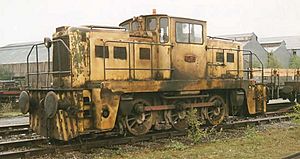British Rail Janus facts for kids
Quick facts for kids Yorkshire Engine Company ‘Janus’ |
|
 |
|
| Typical Janus locomotive at a steelworks. | |
| Power type | Diesel-electric |
|---|---|
| Builder | Yorkshire Engine Company |
| Model | Janus |
| UIC classification | C |
| Wheel diameter | 3 ft 8 in (1.118 m) |
| Locomotive weight | 48 long tons (49 t) |
| Prime mover | 2 Rolls Royce C6SFL engines |
| Traction motors | Rolls Royce |
| Top speed | 23 mph (37 km/h) |
| Power output | 400 hp (300 kW) |
| Tractive effort | 30,000 lbf (133.4 kN) |
Imagine a strong, sturdy train designed to push and pull other railway cars around busy train yards or big factories. That's exactly what the Janus and Taurus locomotives were! Built by the Yorkshire Engine Company, these powerful machines were a bit like the workhorses of the railway world, helping to organize trains and get them ready for their journeys.
These locomotives were known for their unique design and their ability to handle tough jobs. While they were tested by British Railways, they mostly found their homes in industrial settings, like steelworks and power stations, where heavy lifting was an everyday task.
Contents
What is a Janus Locomotive?
The Janus locomotive was a special type of train called a shunting locomotive. Shunting means moving railway wagons or carriages short distances, usually within a train yard, station, or industrial site. These locomotives don't travel long distances at high speeds. Instead, they need to be very powerful at low speeds to push and pull heavy loads.
The Janus was a diesel-electric locomotive. This means it used a diesel engine to power a generator, which then created electricity to drive electric motors connected to the wheels. This system allowed for smooth and powerful movement, which is perfect for shunting. Each Janus locomotive had two powerful Rolls-Royce engines, giving it a total of 400 horsepower. It weighed about 48 tons and could reach a top speed of 23 miles per hour.
Who Built These Locomotives?
The Janus and Taurus locomotives were built by the Yorkshire Engine Company. This company was located in Sheffield, England, and had a long history of building locomotives. They were known for creating reliable and strong engines for various industrial uses.
The Yorkshire Engine Company built many different types of locomotives over the years. The Janus model was one of their more successful designs, with many units being sold to private companies. These companies needed robust locomotives to move materials around their large sites.
Why Were They Tested by British Rail?
In the 1950s, British Railways (BR) was looking to modernize its fleet of locomotives. Many of their older shunting engines were steam-powered. BR wanted to switch to more efficient diesel locomotives. They often borrowed or leased new designs from different manufacturers to see how well they performed.
The Janus and Taurus locomotives were loaned to British Rail for these demonstrations. BR wanted to test if these powerful industrial shunting engines could meet their needs for moving trains around their busy railway yards. They were looking for locomotives that were reliable, easy to maintain, and powerful enough for the job.
What Happened After the Tests?
Even though the Janus and Taurus locomotives were powerful and well-built, British Rail decided not to buy any production versions. This often happened during testing periods. BR had specific requirements, and sometimes a locomotive, while good for industrial use, might not perfectly fit the needs of a large national railway system.
Despite not being chosen by British Rail, the Janus locomotives were very successful in other areas. Many of them were sold to private industries across the United Kingdom. They worked in places like steel mills, coal mines, and power stations. Their strength and reliability made them ideal for these demanding environments. Some Janus locomotives even found homes in other countries, like Jamaica.

